📞+86 153 7530 2641 📧 hongjing.Wang@feichuncables.com

High-Flexibility (N)TMCGCWOEU Medium Voltage Screened Single Core Cable for Shore Power and Energy Chain Applications
Discover the high-flexibility (N)TMCGCWOEU medium voltage screened single core cable designed for shore power, energy chains, and offshore systems. This oil-resistant, UV-stable, and drag-chain compatible cable is ideal for container vessels and port cranes.
hongjing.Wang@Feichun
8/8/202511 min read

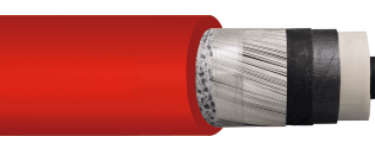
Introduction
Overview of the (N)TMCGCWOEU Cable Series
The (N)TMCGCWOEU medium voltage screened single core cable represents a breakthrough in high-flexibility power transmission technology, specifically engineered for the most demanding industrial applications. Built to DIN VDE 0250-813 standards, this cable series delivers exceptional performance in environments where conventional power cables fail to meet operational requirements. The cable's sophisticated design incorporates advanced materials and construction techniques to ensure reliable power transmission in dynamic applications such as shore power systems, energy chains, and offshore installations.
This premium cable solution addresses the growing need for flexible, durable power transmission in modern industrial settings where equipment mobility, environmental resistance, and operational reliability are paramount. The (N)TMCGCWOEU series stands as a testament to German engineering excellence, combining decades of cable manufacturing expertise with cutting-edge materials science to deliver a product that exceeds industry expectations.
Importance of High-Flexibility Medium Voltage Cables in Industrial Settings
Modern industrial applications demand power transmission solutions that can withstand constant movement, extreme environmental conditions, and varying mechanical stresses. Traditional rigid cables often fail prematurely in dynamic applications, leading to costly downtime, safety hazards, and reduced operational efficiency. High-flexibility medium voltage cables like the (N)TMCGCWOEU series bridge this gap by providing robust power transmission capabilities while maintaining the mechanical flexibility required for continuous motion applications.
The marine and port industries, in particular, have embraced these advanced cable technologies to support shore power connections for container vessels, energy chain systems on port cranes, and offshore power distribution networks. As environmental regulations become more stringent and operational efficiency demands increase, the role of high-performance flexible cables becomes increasingly critical in maintaining competitive advantage and regulatory compliance.
Technical Specifications
Conductor Design and Materials
The (N)TMCGCWOEU cable features a meticulously engineered conductor design utilizing tinned copper wires that are finely stranded to class 5 specifications according to DIN EN/IEC 60228. This premium conductor construction provides exceptional flexibility while maintaining excellent electrical conductivity and corrosion resistance. The tinning process creates a protective barrier against oxidation, ensuring long-term performance even in harsh marine environments.
The finely stranded conductor design allows for repeated flexing without conductor fatigue, a critical requirement for energy chain and reeling applications. Available cross-sections range from 25 mm² to 300 mm², with conductor resistance values optimized for each size to minimize power losses during transmission. The precision manufacturing process ensures consistent electrical and mechanical properties across all cable sizes.
Insulation and Screening System
The cable incorporates a sophisticated three-layer insulation system designed for optimal electrical performance and mechanical durability. The innermost layer consists of a semi-conductive stress control layer that ensures uniform electric field distribution around the conductor, preventing localized stress concentrations that could lead to premature insulation failure.
The primary insulation utilizes an advanced EPR (Ethylene Propylene Rubber) compound with enhanced electrical and mechanical characteristics based on DIN VDE 0207-20 standards. This specialized compound provides excellent dielectric properties, thermal stability, and resistance to mechanical stress. The outer semi-conductive insulation shield layer completes the screening system, ensuring reliable operation at medium voltage levels while maintaining flexibility.
Outer Sheath Properties
The cable's outer sheath employs a heavy-duty rubber compound designated as type 5GM5 according to DIN VDE 0207-21 specifications. This advanced sheath material provides comprehensive protection against environmental hazards including oil, UV radiation, ozone, and moisture. The flame retardant properties meet EN 60332-1-2 standards, while oil resistance complies with EN 60811-404 requirements.
The distinctive red coloration with inkjet marking facilitates easy identification and traceability in complex installations. The sheath's formulation ensures unrestricted use in both indoor and outdoor environments, making it ideal for marine applications where exposure to saltwater, fuel oils, and extreme weather conditions is common.
Thermal and Mechanical Parameters
Operating temperature ranges are carefully specified to ensure optimal performance across diverse environmental conditions. For fixed installations, the cable operates reliably from -50°C to +80°C ambient temperature, while flexible operations are rated from -35°C to +80°C. The maximum permissible conductor temperature is 90°C during normal operation, with short-circuit temperature ratings up to 200°C.
Mechanical parameters include a maximum tensile load of 15 N/mm² per conductor, ensuring the cable can withstand substantial pulling forces during installation and operation. Bending radius specifications vary based on application: fixed installations require a minimum radius of 6 times the outer diameter, while free-moving applications require 8 times the outer diameter. These generous bending radii contribute to the cable's exceptional flexibility and service life.
Voltage Ratings and Permissible Operating Voltages
The (N)TMCGCWOEU series encompasses multiple voltage ratings to meet diverse application requirements. The 3.6/6 kV variant provides maximum permissible operating voltages of 4.2/7.2 kV in AC systems and 5.4/10.8 kV in DC systems. The 6/10 kV version supports AC operation up to 6.9/12 kV and DC operation up to 9/18 kV. Higher voltage variants include 8.7/15 kV (AC) and 13.5/27 kV (DC) for the 12/20 kV rating, with the premium 18/30 kV version supporting AC voltages up to 20.8/36 kV and DC voltages up to 27/54 kV.
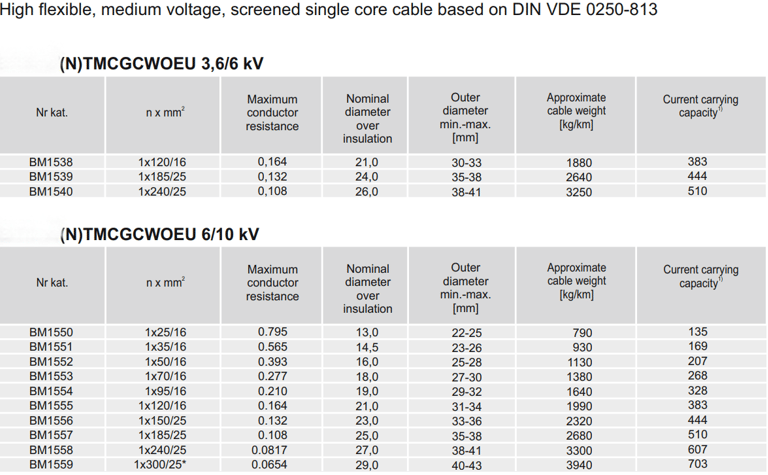

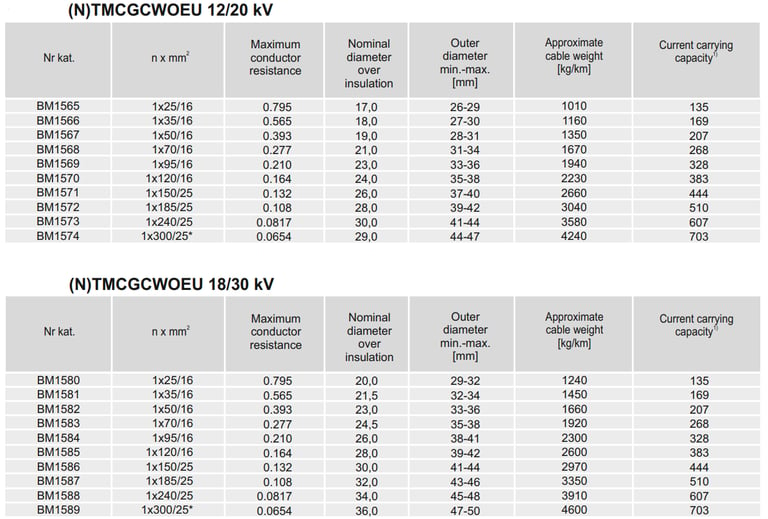

Key Applications
Shore Power Systems for Container Vessels
Shore power applications represent one of the most demanding environments for medium voltage cables. Container vessels requiring shore power connections must contend with tidal movements, vessel loading variations, and harsh marine conditions. The (N)TMCGCWOEU cable's flexible design accommodates these dynamic conditions while maintaining reliable power transmission.
The cable's oil resistance properties are particularly valuable in port environments where hydraulic fluids, fuel oils, and other petroleum products are prevalent. Movement speeds of up to 6 m/min in shore power systems require cables with exceptional flexibility and fatigue resistance, characteristics that the (N)TMCGCWOEU series delivers consistently.
Energy Chains on Port Cranes and Offshore Platforms
Energy chain applications in port cranes subject cables to extreme mechanical stress with movement speeds ranging from 70 to 240 m/min. The (N)TMCGCWOEU cable's advanced conductor stranding and insulation system enable reliable operation under these demanding conditions. The cable's small bending radius capability allows for compact energy chain designs, optimizing space utilization in crane installations.
Offshore platform applications benefit from the cable's comprehensive environmental resistance, including UV stability, ozone resistance, and moisture protection. The cable's ability to operate under water pressure up to 10 bar (protection class AD8) makes it suitable for submerged installations common in offshore environments.
Cable Reels and Reeling Operations
Reeling operations require cables that can withstand repeated winding and unwinding cycles without degradation. The (N)TMCGCWOEU cable's flexible construction and robust outer sheath ensure reliable performance in these applications. The cable's resistance to mechanical stress and its ability to maintain electrical properties through numerous flexing cycles make it ideal for drum reeling systems.
Switch-gear and Transformer House Connections
In confined spaces such as switch-gear and transformer houses, the cable's small bending radius capability proves invaluable. Short cable runs requiring tight routing benefit from the cable's flexibility, while the robust insulation system ensures reliable operation in high-voltage switching environments.

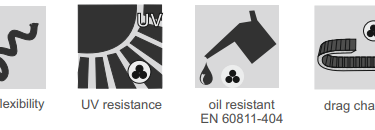
Performance Advantages
Enhanced Flexibility with Small Bending Radius
The (N)TMCGCWOEU cable's ability to achieve tight bending radii without compromising electrical or mechanical integrity sets it apart from conventional medium voltage cables. This flexibility translates to easier installation, reduced space requirements, and improved system design flexibility. The cable's construction allows for repeated flexing without conductor fatigue or insulation degradation.
Drag-Chain Compatibility and High Movement Speed
Purpose-built for dynamic applications, the cable excels in energy chain environments where conventional cables fail. The specialized conductor stranding, advanced insulation system, and robust outer sheath work together to provide exceptional fatigue resistance. The cable maintains its electrical properties even under continuous high-speed movement, ensuring uninterrupted power transmission in critical applications.
Oil Resistance and UV Stability
Environmental resistance is crucial for outdoor and marine applications. The cable's oil resistance properties, verified through DIN EN/IEC 60811-404 testing, ensure reliable operation in contaminated environments. UV stability prevents polymer degradation from sunlight exposure, while ozone resistance maintains sheath integrity in high-ozone environments common in marine settings.
Flame Retardancy and Compliance
Safety compliance is paramount in industrial installations. The cable meets stringent flame retardancy requirements per EN 60332-1-2, preventing fire propagation in cable installations. RoHS 2015/863/EU compliance ensures environmental responsibility, while CPR 305/2011 compliance meets European construction product regulations.


Installation and Handling Guidelines
Fixed vs. Free-Moving Installation Best Practices
Installation methodology significantly impacts cable performance and service life. Fixed installations allow for smaller bending radii (6 times outer diameter) and simplified routing, while free-moving applications require larger bending radii (8 times outer diameter) and careful attention to mechanical stress distribution. Proper support systems and strain relief are essential for both installation types.
Cable routing should minimize sharp edges and avoid contact with abrasive surfaces. In energy chain applications, proper chain selection and cable positioning within the chain are critical for optimal performance. Cable segregation from power and control cables prevents electromagnetic interference and reduces mechanical wear.
Recommended Bending Radii and Tensile Load Limits
Adherence to specified bending radii is crucial for maintaining cable integrity. The minimum bending radius specifications provide safety margins that prevent conductor damage and insulation stress. During installation, pulling tensions should not exceed 15 N/mm² per conductor to prevent permanent deformation or damage.
Temperature considerations during installation are important, as cold temperatures may temporarily reduce cable flexibility. Pre-warming cables in cold conditions can facilitate easier handling and installation. Proper cable handling techniques prevent kinking or crushing that could compromise performance.
Short-Circuit and Emergency Temperature Considerations
Emergency conditions require careful consideration of cable thermal limits. The 200°C short-circuit temperature rating provides substantial margin for fault conditions, but proper protective device coordination is essential to prevent damage. Emergency shutdown procedures should account for cable thermal time constants and cooling requirements.
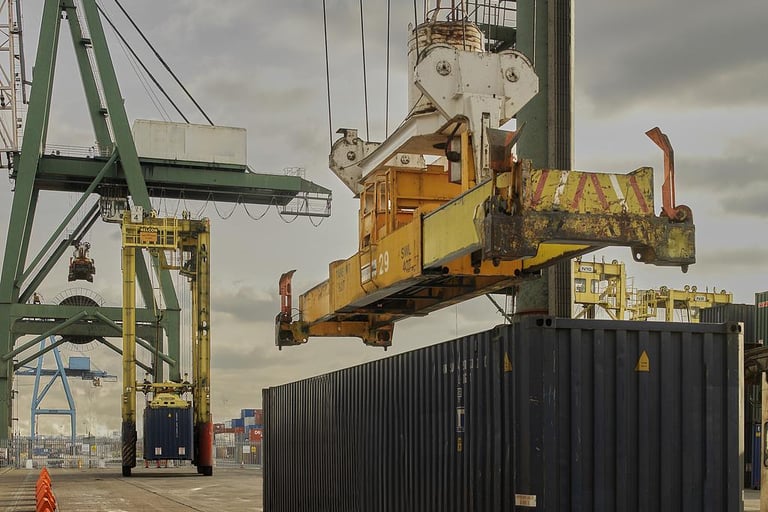

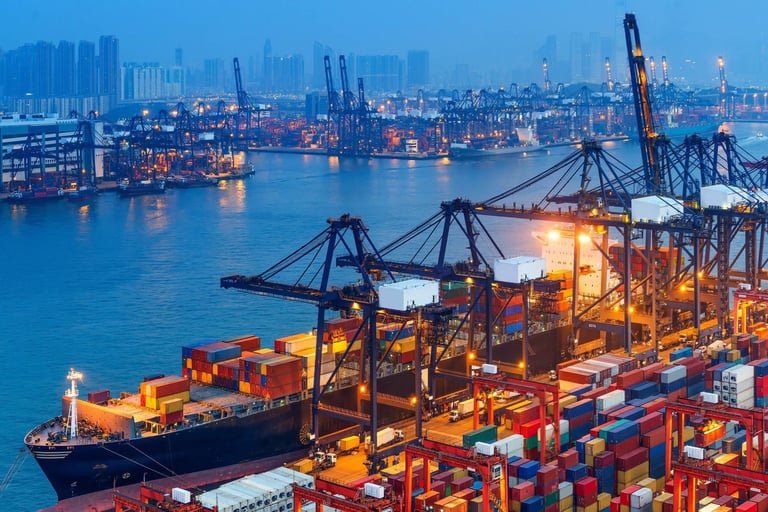

Maintenance and Service Life
Inspection Intervals for Outer Sheath Integrity
Regular inspection programs are essential for maintaining cable reliability. Visual inspections should focus on outer sheath condition, particularly in areas subject to mechanical stress or environmental exposure. Signs of wear, cracking, or contamination require immediate attention to prevent moisture ingress or mechanical failure.
Electrical testing protocols should include insulation resistance measurements and partial discharge testing where applicable. Trending of electrical parameters can identify developing problems before they result in failure. Documentation of inspection results provides valuable data for predictive maintenance programs.
Cleaning and Environmental Precautions
Cleaning procedures should use compatible solvents that do not degrade the outer sheath material. Regular cleaning removes contaminants that could accelerate aging or provide conductive paths for electrical faults. In marine environments, salt removal is particularly important to prevent corrosion of metallic components.
Environmental monitoring helps identify conditions that may accelerate cable aging. Temperature cycling, UV exposure, and chemical contamination levels should be documented and compared to cable specifications to ensure operation within design parameters.
Expected Lifespan Under Continuous Operation
Under proper installation and maintenance conditions, the (N)TMCGCWOEU cable provides extended service life even in demanding applications. The advanced materials and construction techniques contribute to superior aging characteristics compared to conventional cables. Expected service life varies with application severity, environmental conditions, and maintenance quality, but typically exceeds 20 years in properly designed installations.
Customization and Ordering Information
Available Cross-Section Sizes and Current Ratings
The (N)TMCGCWOEU series offers comprehensive size options from 25 mm² to 300 mm² conductors. Current carrying capacities range from 135 A for 25 mm² cables to 703 A for 300 mm² cables, based on IEC 60364-5-52 standards with 90°C conductor temperature and 30°C ambient temperature. These ratings assume free air installation with three loaded conductors in trefoil formation.
Each cable size is optimized for its intended current carrying capacity, with conductor resistance values calculated to minimize losses while maintaining flexibility. The range of available sizes ensures optimal selection for specific application requirements, avoiding oversizing that increases cost and reduces flexibility.
Special Requests for Multi-Core or Alternative Conductor Sizes
Cable Factory FEICHUN accommodates special requirements for alternative cross-sections or multi-core configurations. Custom specifications can address unique application needs while maintaining the cable's fundamental performance characteristics. Engineering support is available to develop solutions for specialized applications requiring modified designs.
Lead times for custom configurations vary based on complexity and quantity requirements. Early consultation with technical specialists ensures optimal cable design for specific applications and facilitates efficient project execution.
UL and IEC Approvals and Certification Details
The cable series maintains comprehensive approvals including UL Certificate no. UL-US-2322574-2/E524140-20230601, ensuring compatibility with North American installations. IEC compliance facilitates international project specifications and ensures consistent performance standards across global installations.
Certification documentation provides verification of compliance with relevant standards and facilitates project approval processes. Regular certification maintenance ensures continued compliance with evolving industry standards and regulatory requirements.
Frequently Asked Questions
Q: What makes the (N)TMCGCWOEU cable suitable for shore power applications on container vessels? A: The cable's exceptional flexibility, oil resistance, and ability to withstand marine environmental conditions make it ideal for shore power connections. Its small bending radius capability accommodates tidal movements and vessel loading variations while maintaining reliable power transmission. The UV-resistant outer sheath and moisture protection ensure long-term performance in harsh marine environments.
Q: How does the cable perform in energy chain applications with high movement speeds? A: The (N)TMCGCWOEU cable is specifically engineered for energy chain applications with movement speeds up to 240 m/min. The finely stranded class 5 conductor and advanced EPR insulation system provide exceptional fatigue resistance. The robust outer sheath protects against mechanical wear while maintaining flexibility throughout millions of flexing cycles.
Q: What environmental conditions can this cable withstand? A: The cable operates reliably in ambient temperatures from -50°C to +80°C for fixed installations and -35°C to +80°C for flexible applications. It provides comprehensive resistance to oil, UV radiation, ozone, and moisture. The cable can operate submerged under water pressure up to 10 bar, making it suitable for both indoor and outdoor installations including harsh marine environments.
Q: What are the key differences between voltage ratings in the series? A: The series offers four voltage ratings: 3.6/6 kV, 6/10 kV, 12/20 kV, and 18/30 kV. Each rating has specific permissible operating voltages for AC and DC systems. Higher voltage ratings feature thicker insulation layers, resulting in larger overall diameters and increased weight per kilometer. Selection depends on system voltage requirements and installation constraints.
Q: How should installation practices differ for energy chain versus fixed applications? A: Energy chain installations require larger minimum bending radii (8 times outer diameter versus 6 times for fixed installations) and careful attention to chain design and cable positioning. Fixed installations can utilize tighter routing but must ensure adequate support and strain relief. Both applications require adherence to maximum tensile load limits during installation and proper consideration of environmental factors.
Conclusion
Summary of (N)TMCGCWOEU Cable Benefits
The (N)TMCGCWOEU medium voltage screened single core cable represents the pinnacle of flexible power transmission technology. Its advanced conductor design, sophisticated insulation system, and robust environmental protection combine to deliver exceptional performance in the most demanding applications. The cable's ability to maintain electrical integrity through millions of flexing cycles while resisting environmental degradation makes it the preferred choice for shore power, energy chains, and offshore installations.
Key benefits include superior flexibility with small bending radius capabilities, comprehensive environmental resistance including oil and UV protection, flame retardant properties for enhanced safety, and compliance with international standards. The cable's design accommodates high movement speeds while maintaining reliable power transmission, essential for modern industrial applications requiring both mobility and reliability.
Why Choose This Cable for Demanding Power Applications
The (N)TMCGCWOEU cable series addresses the critical need for reliable, flexible power transmission in dynamic industrial environments. Its proven performance in shore power systems, energy chains, and offshore applications demonstrates the value of investing in premium cable technology. The cable's extended service life, reduced maintenance requirements, and exceptional reliability translate to lower total cost of ownership despite higher initial investment.
For applications where conventional cables fail to meet performance requirements, the (N)TMCGCWOEU series provides the engineering solution needed to ensure operational success. Its comprehensive certifications, customization capabilities, and technical support make it the optimal choice for demanding power transmission applications requiring the highest levels of performance, reliability, and safety.
How to Reach Us
Get in Touch
SiteMap
Product Catalogue
Reeling Cable
Festoon Cable
Shore Power Cable




Scan to add us on WeChat
